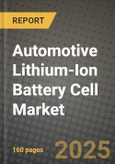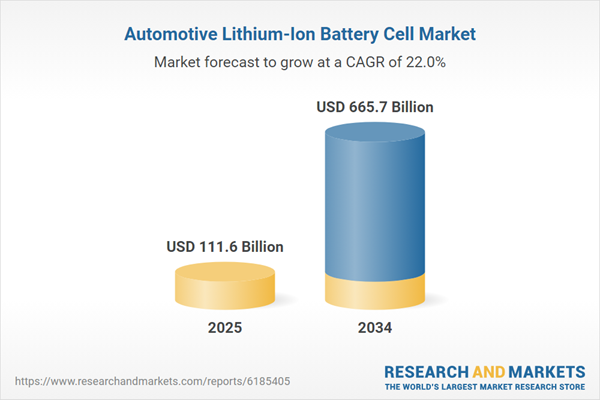The automotive lithium-ion battery cell market is a critical component of the electrification wave sweeping the global automotive industry. Lithium-ion battery cells are the primary energy storage solution for electric vehicles (EVs), plug-in hybrids (PHEVs), and hybrid vehicles (HEVs). They offer high energy density, long cycle life, and relatively fast charging capabilities, making them the technology of choice for automakers looking to reduce emissions and transition away from internal combustion engines.
As EV production scales up, battery cell manufacturers are investing heavily in research and development to improve performance, reduce costs, and enhance safety. Innovations such as solid-state electrolytes, advanced cathode materials, and optimized cell designs are driving improvements in energy density, charging speed, and durability. These advancements are crucial for increasing EV range, reducing charging times, and addressing consumer concerns about battery life and safety.
Despite these technological gains, the market faces challenges such as raw material price volatility, supply chain constraints, and the need for extensive recycling infrastructure. However, growing regulatory support, government incentives, and ongoing innovation are expected to drive continued growth in the automotive lithium-ion battery cell market, making it a cornerstone of the global shift toward sustainable transportation.
Key Insights: Automotive Lithium-Ion Battery Cell Market
A prominent trend in the automotive lithium-ion battery cell market is the development of solid-state batteries. These next-generation batteries replace liquid electrolytes with solid materials, enhancing safety, energy density, and thermal stability. Solid-state technology is expected to play a significant role in the future of EV battery production, offering lighter, more compact cells with improved performance.Another trend is the increasing use of alternative cathode materials. Battery manufacturers are exploring nickel-rich and cobalt-free chemistries to improve energy density and reduce dependence on expensive or ethically contentious materials. These new chemistries aim to deliver more sustainable and cost-effective solutions while maintaining or enhancing performance characteristics.
The rapid growth of the electric vehicle market is the primary driver of the automotive lithium-ion battery cell market. As automakers expand their EV lineups and governments introduce stricter emissions regulations, the demand for high-performance, long-lasting battery cells continues to rise. This demand fuels innovation and drives investment in advanced manufacturing facilities and materials research.
Another driver is the global push for decarbonization and renewable energy integration. Lithium-ion battery cells play a key role in reducing transportation-related greenhouse gas emissions and enabling the widespread adoption of renewable energy sources. Their ability to store and deliver energy efficiently makes them indispensable for achieving long-term environmental and energy goals.
One of the biggest challenges in the automotive lithium-ion battery cell market is raw material supply constraints. The production of lithium, nickel, cobalt, and graphite is subject to geopolitical, environmental, and economic pressures, which can lead to price fluctuations and supply chain bottlenecks. Ensuring a stable and ethical supply chain is critical for meeting the growing demand for battery cells.
Another challenge is the development of effective recycling infrastructure. As the number of EVs on the road increases, the volume of used batteries will also grow. Establishing efficient recycling processes to recover valuable materials and reduce environmental impact is essential for the sustainability of the lithium-ion battery industry. Overcoming these challenges will require collaboration among manufacturers, governments, and researchers to create a more resilient and sustainable battery ecosystem.
Automotive Lithium-Ion Battery Cell Market Segmentation
By Type
- Lithium Iron Phosphate (LFP)
- Lithium Cobalt Oxide (LCO)
- Lithium Manganese Oxide (LMO)
- Lithium Nickel Manganese Cobalt Oxide (NMC)
By Cell Type
- Cylindrical
- Prismatic
- Pouch Cells
By Application
- Battery Electric Vehicle (BEV)
- Plug-In Hybrid Electric Vehicle (PHEV)
- Fuel-Cell Electric Vehicle
Key Companies Analysed
- Samsung SDI Co. Ltd.
- Toshiba Corporation
- Contemporary Ampere Technology Co. Ltd.
- LG Chem Ltd.
- GS Yuasa International Ltd.
- Johnson Controls International Plc
- Panasonic Corporation
- East Penn Manufacturing Co.
- BYD Company Ltd.
- Automotive Energy Supply Corp.
- CROWN BATTERY
- Duracell International Inc.
- Enersys Inc.
- Exide Industries Limited
- Narada Power Source Co. Ltd.
- A123 Systems LLC
- Exicom Power Solutions
- Tesla Inc.
- Hitachi Ltd.
- NEC Corporation
- Envision AESC Limited
- Amperex Technology Limited
- Bader Ahmed Kaiksow Group
- Blue Energy Limited
- CBAK Energy Technology Inc.
- Tianjin Lishen Battery Joint-Stock CO. Ltd.
- Lithion Battery Inc.
- SK innovation Co. Ltd.
- OptimumNano Energy Co. Ltd.
- VARTA AG
- Sony Corporation
- Gotion High-Tech Co. Ltd..
Automotive Lithium-Ion Battery Cell Market Analytics
The report employs rigorous tools, including Porter’s Five Forces, value chain mapping, and scenario-based modeling, to assess supply-demand dynamics. Cross-sector influences from parent, derived, and substitute markets are evaluated to identify risks and opportunities. Trade and pricing analytics provide an up-to-date view of international flows, including leading exporters, importers, and regional price trends.
Macroeconomic indicators, policy frameworks such as carbon pricing and energy security strategies, and evolving consumer behavior are considered in forecasting scenarios. Recent deal flows, partnerships, and technology innovations are incorporated to assess their impact on future market performance.Automotive Lithium-Ion Battery Cell Market Competitive Intelligence
The competitive landscape is mapped through proprietary frameworks, profiling leading companies with details on business models, product portfolios, financial performance, and strategic initiatives. Key developments such as mergers & acquisitions, technology collaborations, investment inflows, and regional expansions are analyzed for their competitive impact. The report also identifies emerging players and innovative startups contributing to market disruption.
Regional insights highlight the most promising investment destinations, regulatory landscapes, and evolving partnerships across energy and industrial corridors.Countries Covered
- North America - Automotive Lithium-Ion Battery Cell market data and outlook to 2034
- United States
- Canada
- Mexico
- Europe - Automotive Lithium-Ion Battery Cell market data and outlook to 2034
- Germany
- United Kingdom
- France
- Italy
- Spain
- BeNeLux
- Russia
- Sweden
- Asia-Pacific - Automotive Lithium-Ion Battery Cell market data and outlook to 2034
- China
- Japan
- India
- South Korea
- Australia
- Indonesia
- Malaysia
- Vietnam
- Middle East and Africa - Automotive Lithium-Ion Battery Cell market data and outlook to 2034
- Saudi Arabia
- South Africa
- Iran
- UAE
- Egypt
- South and Central America - Automotive Lithium-Ion Battery Cell market data and outlook to 2034
- Brazil
- Argentina
- Chile
- Peru
Research Methodology
This study combines primary inputs from industry experts across the Automotive Lithium-Ion Battery Cell value chain with secondary data from associations, government publications, trade databases, and company disclosures. Proprietary modeling techniques, including data triangulation, statistical correlation, and scenario planning, are applied to deliver reliable market sizing and forecasting.Key Questions Addressed
- What is the current and forecast market size of the Automotive Lithium-Ion Battery Cell industry at global, regional, and country levels?
- Which types, applications, and technologies present the highest growth potential?
- How are supply chains adapting to geopolitical and economic shocks?
- What role do policy frameworks, trade flows, and sustainability targets play in shaping demand?
- Who are the leading players, and how are their strategies evolving in the face of global uncertainty?
- Which regional “hotspots” and customer segments will outpace the market, and what go-to-market and partnership models best support entry and expansion?
- Where are the most investable opportunities - across technology roadmaps, sustainability-linked innovation, and M&A - and what is the best segment to invest over the next 3-5 years?
Your Key Takeaways from the Automotive Lithium-Ion Battery Cell Market Report
- Global Automotive Lithium-Ion Battery Cell market size and growth projections (CAGR), 2024-2034
- Impact of Russia-Ukraine, Israel-Palestine, and Hamas conflicts on Automotive Lithium-Ion Battery Cell trade, costs, and supply chains
- Automotive Lithium-Ion Battery Cell market size, share, and outlook across 5 regions and 27 countries, 2023-2034
- Automotive Lithium-Ion Battery Cell market size, CAGR, and market share of key products, applications, and end-user verticals, 2023-2034
- Short- and long-term Automotive Lithium-Ion Battery Cell market trends, drivers, restraints, and opportunities
- Porter’s Five Forces analysis, technological developments, and Automotive Lithium-Ion Battery Cell supply chain analysis
- Automotive Lithium-Ion Battery Cell trade analysis, Automotive Lithium-Ion Battery Cell market price analysis, and Automotive Lithium-Ion Battery Cell supply/demand dynamics
- Profiles of 5 leading companies - overview, key strategies, financials, and products
- Latest Automotive Lithium-Ion Battery Cell market news and developments
Additional Support
With the purchase of this report, you will receive:- An updated PDF report and an MS Excel data workbook containing all market tables and figures for easy analysis.
- 7-day post-sale analyst support for clarifications and in-scope supplementary data, ensuring the deliverable aligns precisely with your requirements.
- Complimentary report update to incorporate the latest available data and the impact of recent market developments.
This product will be delivered within 1-3 business days.
Table of Contents
Companies Mentioned
- Samsung SDI Co. Ltd.
- Toshiba Corporation
- Contemporary Ampere Technology Co. Ltd.
- LG Chem Ltd.
- GS Yuasa International Ltd.
- Johnson Controls International PLC
- Panasonic Corporation
- East Penn Manufacturing Co.
- BYD Company Ltd.
- Automotive Energy Supply Corp.
- CROWN BATTERY
- Duracell International Inc.
- Enersys Inc.
- Exide Industries Limited
- Narada Power Source Co. Ltd.
- A123 Systems LLC
- Exicom Power Solutions
- Tesla Inc.
- Hitachi Ltd.
- NEC Corporation
- Envision AESC Limited
- Amperex Technology Limited
- Bader Ahmed Kaiksow Group
- Blue Energy Limited
- CBAK Energy Technology Inc.
- Tianjin Lishen Battery Joint-Stock CO. Ltd.
- Lithion Battery Inc.
- SK innovation Co. Ltd.
- OptimumNano Energy Co. Ltd.
- VARTA AG
- Sony Corporation
- Gotion High-Tech Co. Ltd. .
Table Information
| Report Attribute | Details |
|---|---|
| No. of Pages | 160 |
| Published | October 2025 |
| Forecast Period | 2025 - 2034 |
| Estimated Market Value ( USD | $ 111.6 Billion |
| Forecasted Market Value ( USD | $ 665.7 Billion |
| Compound Annual Growth Rate | 21.9% |
| Regions Covered | Global |
| No. of Companies Mentioned | 32 |









